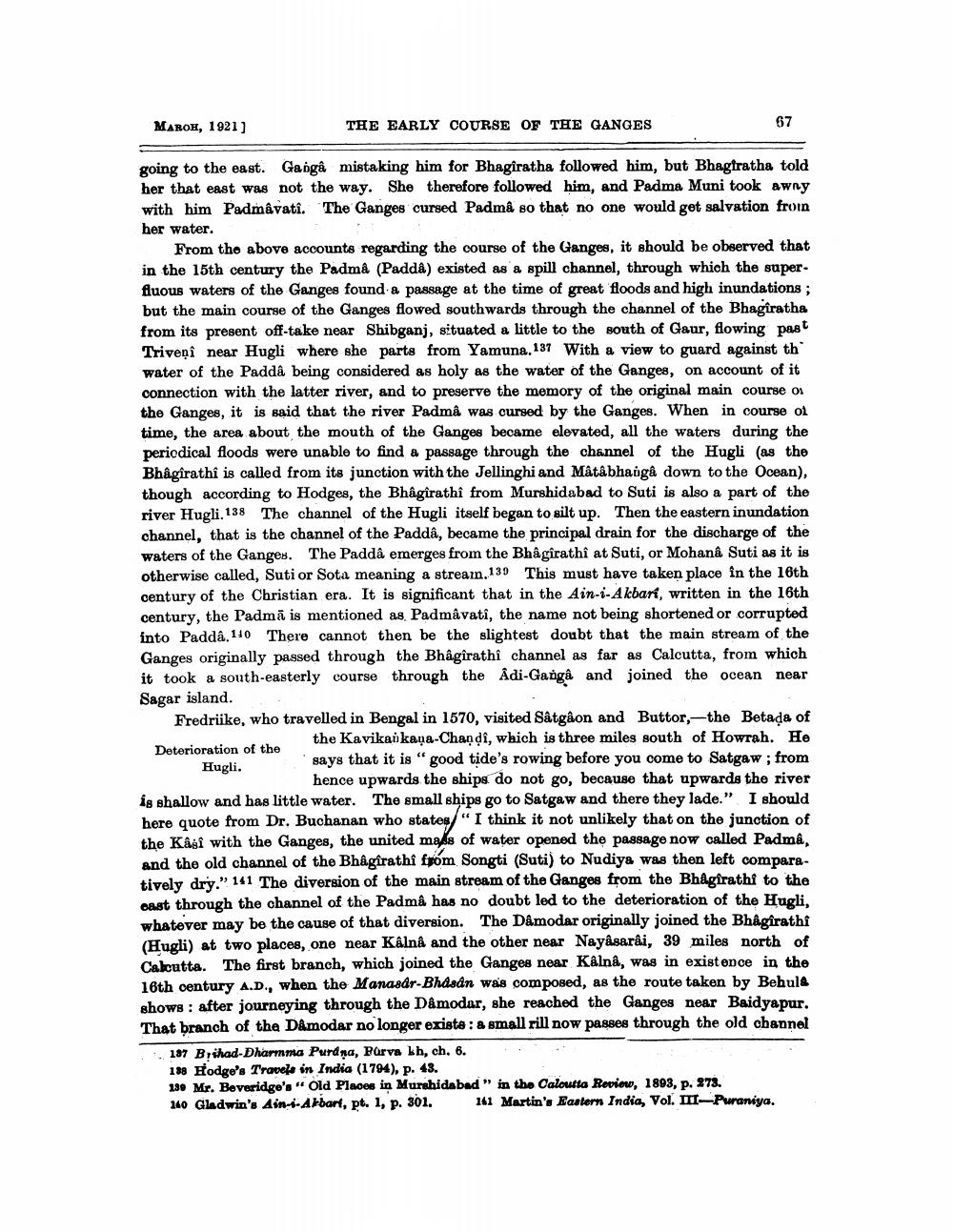________________
MAROH, 1921)
THE EARLY COURSE OF THE GANGES
67
going to the east. Ganga mistaking him for Bhagiratha followed him, but Bhagtratha told her that east was not the way. She therefore followed him, and Padma Muni took awny with him Padmavati. The Ganges cursed Padmâ so that no one would get salvation froin her water.
From the above accounts regarding the course of the Ganges, it should be observed that in the 15th century the Padma (Padda) existed as a spill channel, through which the superfluous waters of the Ganges found a passage at the time of great floods and high inundations ; but the main course of the Ganges flowed southwards through the channel of the Bhagiratha from its present off-take near Shibganj, situated a little to the south of Gaur, flowing past Triveņi near Hugli where she parts from Yamuna. 137 With a view to guard against th water of the Paddå being considered as holy as the water of the Ganges, on account of it connection with the latter river, and to preserve the memory of the original main course ou the Ganges, it is said that the river Padmâ was cursed by the Ganges. When in course of time, the area about the mouth of the Ganges became elevated, all the waters during the periodical floods were unable to find a passage through the channel of the Hugli (as the Bhagirathi is called from its junction with the Jellinghi and Mâtâbhaigâ down to the Ocean), though according to Hodges, the Bhagirathi from Murshidabad to Suti is also a part of the river Hugli, 138 The channel of the Hugli itself began to silt up. Then the eastern inundation channel, that is the channel of the Padda, became the principal drain for the discharge of the waters of the Ganges. The Paddå emerges from the Bhâgirathi at Suti, or Mohana Suti as it is otherwise called, Suti or Sota meaning a stream.139 This must have taken place in the 16th century of the Christian era. It is significant that in the Ain-i-Akbart, written in the 16th century, the Padmā is mentioned as Padmavati, the name not being shortened or corrupted into Paddå.110 There cannot then be the slightest doubt that the main stream of the Ganges originally passed through the Bhagirathi channel as far as Calcutta, from which it took a south-easterly course through the Adi-Ganga and joined the ocean near Sagar island. Fredriike, who travelled in Bengal in 1570, visited Sâtgâon and Buttor,—the Betada of
the Kavikaukana-Chandî, which is three miles south of Howrah. He Deterioration of the Hugli.
says that it is "good tide's rowing before you come to Satgaw; from
hence upwards the ships do not go, because that upwards the river is shallow and has little water. The small ships go to Satgaw and there they lade." I should here quote from Dr. Buchanan who states/" I think it not unlikely that on the junction of the Kaal with the Ganges, the united mass of water opened the passage now called Padma. and the old channel of the Bhagirathi fpom Songti (Suti) to Nudiya was then left comparatively dry." 141 The diversion of the main stream of the Ganges from the Bhagirathi to the oast through the channel of the Padma has no doubt led to the deterioration of the Hugli, whatever may be the cause of that diversion. The Damodar originally joined the Bhagirathi (Hugli) at two places, one near Kálna and the other near Nayasardi, 39 miles north of Calcutta. The first branch, which joined the Ganges near Kalna, was in existence in the 16th century A.D., when the Manasdr-Bhasan was composed, as the route taken by Bebule shows : after journeying through the Damodar, she reached the Ganges near Baidyapur. That branch of the DÅmodar no longer existe: a small rill now passes through the old channel
107 Bihad-Dharmma Purdņa, Purva bh, ch. 6. 189 Fodge's Travele in India (1794), p. 43. 139 Mr. Boveridge's "Old Places in Murshidabad " in the Caloutta Review, 1893, p. 273. 140 Gladwin's Ain-s-Akbart, pt. 1, p. 301, 141 Martin's Eastern India, Vol. -Puraniya.




